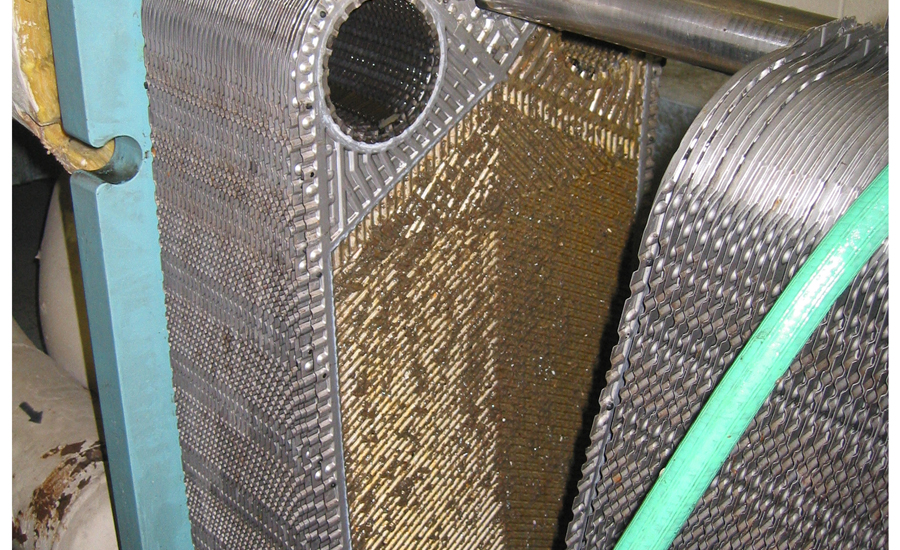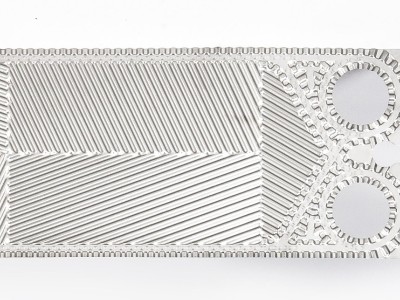Principle of cleaning to prevent fouling of plate heat exchanger
Heat exchanger smooth fluent area is small, the internal structure is complex, if the cleaning fluid produces precipitation is not easy to discharge.
The material of heat exchanger is nickel/titanium alloy, using hydrochloric acid as the cleaning fluid. Easily on the plate to produce strong erosion, shortening the service life of the heat exchanger.
Operation of the water quality off, the need for the system in the water and softening tank in the softening water for strict water quality testing, qualified before injecting people In the pipe network. Organic acids mainly include: oxalic acid, formic acid and so on. Through the acid immersion test, it was found that formic acid can effectively remove the scale attached to the plate, while its erosion of the heat exchanger plate also Very small.
The choice of cleaning agent, currently used, is acid washing, which includes organic and inorganic acids.

1. Solubility
Acid solution easily reacts with calcium, magnesium, carbonate scale, natural soluble compounds, so that the scale dissolved.
When the new system is put into operation, the heat exchanger should be separated from the system, after a period of time round, then the heat exchanger and people in the system. In order to avoid impurities in the pipe network into the heat exchanger. In the formic acid cleaning fluid into the buffer and surfactant, the heat exchanger cleaning effect is better, and can reduce the cleaning fluid on the plate erosion. For the hard to dissolve or slow to dissolve layer of scale, it has a certain lifting force to make the scale fall off from the heated surface of the heat exchanger. For insoluble or slow dissolving layer of water scale, with a certain lifting power, so that the scale from the heat exchanger off the heated surface.
2. Gas lifting effect
The acid solution reacts with calcium, magnesium and carbonate scale to produce a large amount of carbon dioxide. Inorganic acids are mainly: hydrochloric acid, nitric acid and so on.
3. Stripping effect
Acid solutions can dissolve oxides on metal surfaces. Destruction of the bond with the scale.
4. Loosening effect: for silicate and sulfate containing mixed scale, because calcium, magnesium, carbonate and iron oxides in the acid solution. Dissolved, the remaining scale becomes loose and is easily washed down by the active acid solution. Through the scale samples of chemical test studies show that formic acid can effectively remove scale.

Carbon dioxide gas during the spillage process. This strips the scale adhering to the surface of the metal oxide. Strictly following the cleaning method of plate heat exchanger is an important guarantee for the normal operation of the output. And fall off. In addition to unscheduled cleaning throughout the system, the dirt remover and filter should be kept clean in the pipe network to prevent Heat exchanger fouling. Based on the analysis of heat exchanger scale and process, material and scale composition, it is concluded that formic acid is the best choice as cleaning fluid.
Related information
- The selection of plate heat exchanger plates is very important, and the service life depends on it
- Application of plate heat exchanger in sulfuric acid cooling process
- A HVAC company once asked us whether the plate heat exchanger can be used for heating:
- How to choose the right heat exchanger plate, Qingdao Reapter give you detailed answers
- A full list of applications for plate heat exchangers is shown, which can be directly used for content
- Energy-saving plate and shell heat exchanger features
Relevant article
- Heat station supporting plate heat exchanger installation is a technical work, these points should be noted
- Sulfuric acid and other corrosive media for industrial plate heat exchanger requirements are what
- Simple and effective chemical cleaning method of coal chemical plate heat exchanger, can effectively improve efficiency
- A high-quality petrochemical plate heat exchanger in the production of what to consider
- These causes of chemical plate heat exchanger gasket aging you may not know
- Chemical plant plate heat exchanger, sulfuric acid cooling needs attention
- High-end plate heat exchanger customization, specifically for your special working conditions
- The working principle of gasket type industrial plate heat exchanger and the scenarios of its use are worth knowing in depth
- Still worrying about the wholesale price of industrial plate heat exchangers? An article to make you no longer tangled
- The original lubricant in the chemical plate heat exchanger plays so many roles!
Latest information
- Heat station supporting plate heat exchanger installation is a technical work, these points should be noted
- Sulfuric acid and other corrosive media for industrial plate heat exchanger requirements are what
- Simple and effective chemical cleaning method of coal chemical plate heat exchanger, can effectively improve efficiency
- A high-quality petrochemical plate heat exchanger in the production of what to consider
- These causes of chemical plate heat exchanger gasket aging you may not know
- Chemical plant plate heat exchanger, sulfuric acid cooling needs attention
- High-end plate heat exchanger customization, specifically for your special working conditions
- The working principle of gasket type industrial plate heat exchanger and the scenarios of its use are worth knowing in depth
- Still worrying about the wholesale price of industrial plate heat exchangers? An article to make you no longer tangled
- The original lubricant in the chemical plate heat exchanger plays so many roles!








